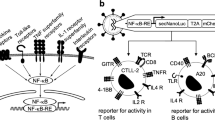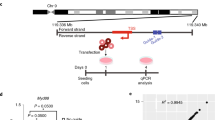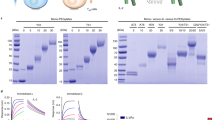Abstract
A therapeutic dilemma often complicates the management of inflammatory diseases; the benefits gained from reducing inflammation must be balanced against the potentially harmful consequences of chronic immunosuppression. Gene therapy might address this dilemma by producing anti-inflammatory proteins in response to a patient's endogenous signals, so that recombinant drug production is linked to the intensity and duration of the inflammatory condition. To test this, we have developed inflammation-inducible systems for regulating recombinant protein production in vivo. We describe a two-component expression construct in which (1) the murine complement factor 3 (C3) promoter regulates production of the human immunodeficiency virus (HIV) transactivator of transcription (Tat), and (2) the Tat protein then stimulates protein expression from genes inserted downstream of the the HIV promoter. When incorporated into a nonreplicating adenovirus (Ad.C3-tat/HIV-luc) and studied in a murine model, the construct produces large amounts of recombinant protein in vivo in response to two different inflammatory stimuli.
This is a preview of subscription content, access via your institution
Access options
Subscribe to this journal
Receive 12 print issues and online access
$209.00 per year
only $17.42 per issue
Buy this article
- Purchase on Springer Link
- Instant access to full article PDF
Prices may be subject to local taxes which are calculated during checkout
Similar content being viewed by others
References
Varley, A.W., Coulthard, M.G., Meidell, R.S., Gerard, R.D. and Munford, R.S. 1995. Inflammation-induced recombinant protein expression in vivo using promoters from acute phase protein genes. Proc. Natl. Acad. Sci. USA 92: 5346–5350.
Fantuzzi, G. and Dinarello, C.A. 1996. The inflammatory response in interleukin-1-deficient mice: Comparison with other cytokine-related knock-out mice. J. Leukocyte Biol. 59: 489–493.
Herz, J. and Gerard, R.D. 1993. Adenovirus-mediated transfer of low density lipoprotein receptor gene acutely accelerates cholesterol clearance in normal mice. Proc. Natl. Acad. Sci. USA 90: 2812–2816.
Rogy, M.A., Auffenberg, T., Espat, N.J., Philip, R., Remick, D., Wollenberg, G.K. et al. 1995. Human tumor necrosis factor receptor (p55) and interleukin 10 gene transfer in the mouse reduces mortality to lethal endotoxemia and also attenuates local inflammatory responses. J. Exp. Med. 181: 2289–2293.
Kolls, J., Peppel, K., Silva, M. and Beutler, B. 1994. Prolonged and effective blockade of tumor necrosis factor activity through adenovirus-mediated gene transfer. Proc. Natl. Acad. Sci. USA 91: 215–219.
Conary, J.T., Parker, R.E., Christman, B.W., Faulks, R.D., King, G.A., Meyrick, B.O. and Brigham, K.L. 1994. Protection of rabbit lungs from endotoxin injury by in vivo hyperexpression of the prostaglandin G/H synthase gene. J. Clin. Invest. 93: 1834–1840.
Kolls, J.K., Lei, D., Nelson, S., Summer, W.R., Greenberg, S. and Beutler, B. 1995. Adenovirus-mediated blockade of tumor necrosis factor in mice protects against endotoxic shock yet impairs pulmonary host defense. J. Infect. Dis. 171: 570–575.
Greenberger, M.J., Kunkel, S.L., Strieter, R.M., Lukacs, N.W., Bramson, J., Gauldie, J. et al. 1996. IL-12 gene therapy protects mice in lethal Klebsiella pneumonia. J. Immunol. 157: 3006–3012.
Kawamura, N., Singer, L., Wetsel, R.A. and Colten, H.R. 1992. Cis- and transacting elements required for constitutive and cytokine-regulated expression of the mouse complement C3 gene. Biochem. J. 283: 705–712.
Osborn, L., Kunkel, S. and Nabel, G.J. 1992. Tumor necrosis factor and interleukin 1 stimulate the human immunodeficiency virus enhancer by activation of the nuclear factor κB. Proc. Natl. Acad. Sci. USA 86: 2336–2340.
Ou, S.-H.l., and Gaynor, R.B. 1992. Intracellular factors involved in gene expression of human retroviruses. pp. 97–184 in The Retroviridae Vol. 4 Levy, J.A. (ed.) Plenum Press, New York, NY.
Huard, J., Lochmüller, H., Acsadi, G., Jani, A., Massie, B. and Karpati, G. 1995. The route of administration is a major determinant of the transduction efficiency of rat tissues by adenoviral recombinants. Gene Therapy 2: 107–115.
Coulthard, M.G., Swindle, J., Munford, R.S., Gerard, R.D. and Meidell, R.S. 1996. Adenovirus-mediated transfer of a gene encoding acyloxyacyl hydrolase (AOAH) into mice increases tissue and plasma AOAH activity. Infect. Immun. 64: 1510–1515.
Tripathy, S.K., Black, H.B., Goldwasser, E. and Leiden, J.M. 1996. Immune responses to transgene-encoded proteins limit the stability of gene expression after injection of replication-defective adenovirus vectors. Nature Medicine 2: 545–550.
Worgall, S., Wolff, G., Falck-Pedersen, E. and Crystal, R.G. 1997. Innate immune mechanisms dominate elimination of adenoviral vectors following in vivo administration. Hum. Gene Ther. 8: 37–44.
Ott, M., Emiliani, S., Van Lint, C., Herbein, G., Lovett, J., Chirmule, N. et al. 1997. Immune hyperactivation of HIV-1 -infected T cells mediated by tat and the CD28 pathway. Science 275: 1481–1485.
Scala, G., Ruocco, M.R., Ambrosino, C., Mallardo, M., Giordano, V., Baldassarre, F. et al. 1994. The expression of the interleukin 6 gene is induced by the human immunodeficiency virus 1 TAT protein. J. Exp. Med. 179: 961–971.
Verhoef, K., Klein, A. and Berkhout, B. 1996. Paracrine activation of the HIV-1 LTR promoter by the viral tat protein is mechanistically similar to trans-activation within a cell. Virology 225: 316–327.
Westendorp, M.O., Shatrov, V.A., Schulze-Osthoff, K., Frank, R., Kraft, M., Los, M. et al. 1995. HIV-1 Tat potentiates TNF-induced NF-kB activation and cytotoxicity by altering the cellular redox state. EMBO J. 14: 546–554.
Brigham, K.L. and Stecenko, A.A. 1995. Gene therapy in acute critical illness. New Horizons 3: 321–329.
Garcia, J.A., Wu, F.K., Mitsuyasu, R. and Gaynor, R.B. 1987. Interactions of cellular proteins involved in the transcriptional regulation of the human immunodeficiency virus. EMBO J. 6: 3761–3770.
Andersson, S., Davis, D.N., Dahlback, H., Jornvall, H. and Russell, D.W., 1989. Cloning, structure, and expression of the mitochondrial cytochrome P-450 sterol 26-hydroxylase, a bile acid biosynthetic enzyme. J. Biol. Chem. 264: 8222–8229.
Gerard, R.D. and Meidell, R.S. 1995. Adenoviral vectors, pp. 285–306 in DNA cloning: A practical approach. Hames, B.D. and Glover, D.M. (eds.) Oxford University Press, Oxford and New York.
Salkowski, C.A., Neta, R., Wynn, T.A., Strassmann, G., Van Rooijen, N. and Vogel, S.N. 1980. Effect of liposome-mediated macrophage depletion on LPS-induced cytokine gene expression and radioprotection. J. Immunol. 155: 3168–3179.
Author information
Authors and Affiliations
Rights and permissions
About this article
Cite this article
Varley, A., Geiszler, S., Gaynor, R. et al. A two-component expression system that responds to inflammatory stimuli in vivo. Nat Biotechnol 15, 1002–1006 (1997). https://doi.org/10.1038/nbt1097-1002
Received:
Accepted:
Issue Date:
DOI: https://doi.org/10.1038/nbt1097-1002
This article is cited by
-
IL10 Released by a New Inflammation-regulated Lentiviral System Efficiently Attenuates Zymosan-induced Arthritis
Molecular Therapy (2013)
-
Computational Design and Application of Endogenous Promoters for Transcriptionally Targeted Gene Therapy for Rheumatoid Arthritis
Molecular Therapy (2009)
-
Application of a disease-regulated promoter is a safer mode of local IL-4 gene therapy for arthritis
Gene Therapy (2007)
-
Technology Insight: gene transfer and the design of novel treatments for rheumatoid arthritis
Nature Clinical Practice Rheumatology (2006)
-
Stellenwert der Gentherapie in Unfallchirurgie und Orthopädie
Der Unfallchirurg (2006)



